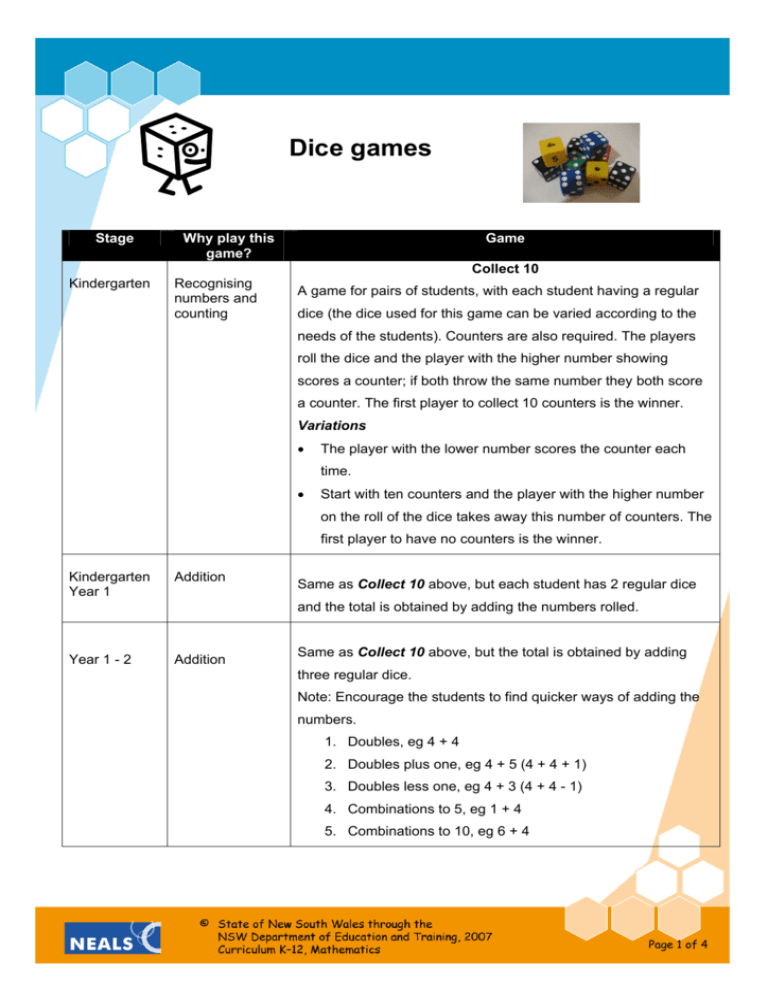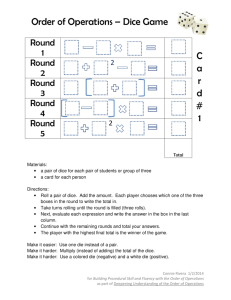Dice games - Curriculum Support
advertisement

Dice games Stage Why play this game? Game Collect 10 Kindergarten Recognising numbers and counting A game for pairs of students, with each student having a regular dice (the dice used for this game can be varied according to the needs of the students). Counters are also required. The players roll the dice and the player with the higher number showing scores a counter; if both throw the same number they both score a counter. The first player to collect 10 counters is the winner. Variations • The player with the lower number scores the counter each time. • Start with ten counters and the player with the higher number on the roll of the dice takes away this number of counters. The first player to have no counters is the winner. Kindergarten Year 1 Addition Same as Collect 10 above, but each student has 2 regular dice and the total is obtained by adding the numbers rolled. Year 1 - 2 Addition Same as Collect 10 above, but the total is obtained by adding three regular dice. Note: Encourage the students to find quicker ways of adding the numbers. 1. Doubles, eg 4 + 4 2. Doubles plus one, eg 4 + 5 (4 + 4 + 1) 3. Doubles less one, eg 4 + 3 (4 + 4 - 1) 4. Combinations to 5, eg 1 + 4 5. Combinations to 10, eg 6 + 4 Page 1 of 4 Stage Why play this game? Game Cross out Year 1 - 2 Addition Cross out is an activity for two students. Each student writes the numbers 2, 3, 4, 5, 6, 7, 8, 9, 10, 11, and 12 on a piece of paper. They take turns to roll two regular dice, add both numbers rolled and cross out the total on their piece of paper. The first player to cross out all the numbers is the winner. Take 100 Year 2 - 6 Subtraction Each student begins with 100 points. In turn, students roll a regular dice and subtract the number from their 100 points. The first player to reach zero is the winner. Variations • Change the number of points to begin. • The students may roll two regular dice and either add or multiply the numbers together before subtracting from the total. Make 24 Year 2 - 4 Addition This game for individuals requires only 1 dice. The player throws the dice repeatedly, listing the numbers thrown in columns as follows. 1 2 3 4 1 2 4 2 4 5 6 6 2 The player has to keep a running total of each column in their head and stop when one of the columns reaches exactly 24 (The fifth column will never reach 24). Players play the game several times and compare their findings. Make 100 Year 4 - 8 Addition An activity for two players. Subtraction Equipment: two regular dice, paper and pencil Page 2 of 4 Stage Why play this game? Multiplication Game The aim is to make a total of 100 or as close to 100 as possible. Division Players take turns to roll the two dice and combine the numbers with any operation to produce a score. The player who reaches 100 or is closest to 100 is the winner. Encourage players to record their choices and calculations. For example: Dice throw Calculation Running total 4 and 6 4 x 6 = 24 24 1 and 4 1+4=5 29 2 and 5 2 x 5 = 10 39 6 and 6 6 x 6 = 36 75 5 and 3 5 x 3 = 15 90 2 and 3 2+3=5 95 6 and 1 6–1=5 100 Double, halve or stay Year 4 - 8 Multiplication An activity for two to four players Division Equipment: two different coloured regular dice Decide on one coloured dice to represent the tens and the other to represent the ones. Choose a target number between 5 and 122. Players take turns to roll the dice. Once the dice are rolled a number is formed. The player then makes a decision to produce a number that is as close as possible to the target number. They can choose to: • double their number • halve their number • keep the number as is The player closest to the target is the winner. Total three Year 4 - 8 Addition An activity for two players. Subtraction Equipment: two regular dice, paper and pencil Multiplication Players take turns to roll the two dice and complete the following calculations on each roll: Page 3 of 4 Stage Why play this game? Game • add the two numbers shown on the dice • find the difference between the two numbers • multiply the two numbers • add the three numbers to produce the score for that round For example 6+3=9 6–3=3 6 x 3 = 18 Score = 9 + 3 + 18 = 30 After 10 rounds the player with the highest total is the winner. To make the activity more challenging change the type of dice used to 8, 10, 12 or 20 sided. Cross out 9 Year 2 - 6 Addition An activity for two to four players. Strategy Equipment: two regular dice, paper and pencil Each player writes the numbers 1 to 9 on a piece of paper. The first player rolls the two dice then crosses out the numbers shown on the dice or the sum of the two numbers. For example On this roll, the player may cross out 2, 3 or 5 (2 + 3). When six numbers or less are left only a single dice is used. The player’s turn continues until they cannot cross off any more numbers. The remaining numbers are totaled and this is the score for that round. After five rounds the player with the smallest total wins. Page 4 of 4




